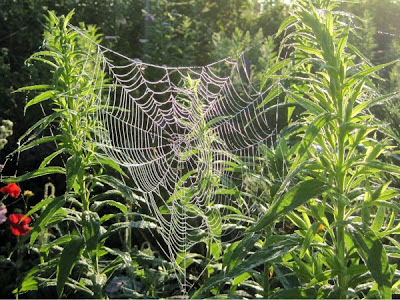With all the advances of today's amazing science and technology, you'd think we could have reproduced something as simple and ubiquitous as spider silk. But no, it still hasn't(?) been done.
If you see a typical one in your garden, there's about 65-195 feet of silk in it. The threads may be sticky, spokes, bridge threads, signal threads to inform the spider of captured prey, drag lines to give the spider access.
Signal threads communicate both the angle and the distance of the prey from the web's center. Somehow the intensity of the vibrations sensed through the spider's eight legs tell it where the captured prey is, and it can store three different prey locations.
Proteins in various combinations give the web features like stretchiness, flexibility and toughness.
"Every set of initial anchor points is different; the number of radii is contingent on opportunity; the beginning of the sticky spiral depends on where the longest several radii turn out to be. In short, each web is a custom production.”
from Evolution News
(cont'd tomorrow)

No comments:
Post a Comment